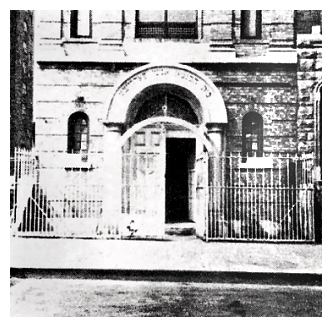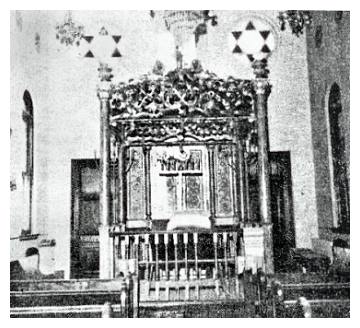 |
 |
(Benjamin's Mess) in New York
- the Holy Ark
|
[English page 3]
In the year 1939, before the outbreak of World War II, it had a population of 6000, 3200 of whom were Jews. The Jews were the dynamic element in the town's economic and cultural life, and like most of the towns in Galicia and Ukraina, it was a Jewish town in the full meaning of the word.
The first Jews settled in Podhajce as far back as the beginning of the 16th Century, and towards the middle of the 16th Century a regular Jewish community was already in existence. In the years 1580 to 1620, a great Rabbi, named Benjamin Aharon Solnik, who took up residence in Podhajce became famous in the Jewish world because of his essay “Benjamins's Mess” which is a collection of questions and answers in matters concerned with “Halacha” (the synagogue of those originating from Podhajce in New York is called Benjamin's Mess, after the name of the book by this Rabbi).
|
|
|||
| Podhajder Synagogue “Mas'sat Benjamin” (Benjamin's Mess) in New York |
Podhajcer Synagogue in New York - the Holy Ark |
Also after Rabbi Benjamin A. Solnik, great Rabbis who made the town's name famous in all the Diaspora, took up residence in Podhajce.
Towards the end of the 17th Century, 1667-1699, the Jews of Podhajce suffered from the invasion of the Turks and the Tatars, and together with their Polish neighbours they defended the town against the enemy. Jan Sobieski, the famous Polish King, repulsed the Turks from Podhajce in 1667, and in memory . of this event, an impressive monument was erected in the town (see photo on page 43).
The great suffering that was caused to Podhajce and the neighbouring towns during the period of the Turkish invasion, perhaps caused many to believe that redemption is round the corner and to join those believers in the false Messias Shabtai Zvi, 1626-1676. Also in the Frankish movement in the year 1750-1760, many of the Podhajce Jews participated, and some of them even went over to Christianity in 1759 together with Jacob Frank.
Upon the division of Poland in 1772, all Galicia passed to the Austro-Hungarian Monarchy. With the outbreak of World War I, in 1914, the Austrian rule in Eastern Galicia came to an end. During the years of the first World War the whole region was controlled by the Russian Army, and at the end of the war upon the establishment of the Polish State, In1918, all Galicia passed to the Poles.
[English page 4]
In 1939, the World War II broke out with the invasion of the German Hitlerite Army into Poland. During the first years of the war, up to June 1941, the Russians, who occupied Poland's border areas according to the Molotov-Ribbentrop agreement, ruled the town.
However immediately upon the outbreak of the war between Germany and Russia, the Russians were compelled to withdraw and the German army occupied the whole of Galicia and continued to advance eastwards within the Russian Ukraine.
In the first year of their rule, the Nazis confined themselves to the oppression of the Jews and depriving them of their fundamental rights of free movement, the purchase of requirements etc. Also various contributions which were collected by cruel means were imposed and many of the men were recruited to compulsory work in labour camps which were set up in the area. The labour camps were, in effect, death camps, where the Jews did hard labour and there was a shortage of food, and for the slightest offence, the “offenders” were shot dead.
The first “operation” in Podhajce was in 1942 on Yom Kippur. The Gestapo, helped by the Ukrainian Police, surrounded the city, took about 1000 men and women out of their houses and took them to the railway station. There the people were placed in great congestion into railway trucks and were sent to the Belsetz Destruction Camp. Only a few people succeeded jumping out of the truck whilst the train was in motion, and then returned to Podhajce.
After the first operation, a Ghetto was set up in a small part of the town and all the Jews were ordered to go into the Ghetto within 24 hours. Congestion in the Ghetto was very great, and consequently, typhus broke out. The Germans made surprise raids in the Ghetto from time to time and whoever was ill was shot dead. They could leave the Ghetto for one hour a day only to buy food from the neighbouring farmers and whoever was found coming back after time was mercilessly beaten up by the Ukrainian Militia who were guarding the entrance to the Ghetto.
The second operation was made a short time after the first. This time too, the victims were sent to the destruction camp, in the same way as in the first action.
During the whole winter period, there were no further operations. With the coming of the spring at Pesach time, rumours circulated that the town would be proclaimed as “Judenrein” (Jew free) and no Jew was permitted to remain in it. And indeed the Germans, some weeks later, announced that all Jews who remained in town must present themselves in the market square. Whoever could find hiding, hid and did not come to the market square. However only a few could find a safe hideout and the great majority of the Jews were concentrated in the market square from whence they were brought to “Holendra”.There they were ordered to dig the big grave -a mass grave - and all of them were shot dead near the hole into which they fell. Many of them fell into the grave while they were still alive, after they were either seriously injured or not injured at all. More then 1300 Jews were killed and buried that day.
The third operation - the operation of annihilation of Podhajce Jews took place three days before Shavout, on the third day of the month of Sivan. On this date the organisation of Podhajce immigrants in Israel arrange for a yearly memorial Service in memory of the holy victims.
After this action about 800 Jews still remained. Three days later they were ordered to gather at the market place, whence they would be sent to the Ghetto of Tarnopol. But as they came to Zahajce they were ordered to dig a mass grave and all of them were shot dead and buried there.
[English page 5]
At the end of World War II, only some dozens out of the Jewish population of Podhajce and the surroundings - at one time numbering 4000 people - remained. The majority of the rescued came to Israel, part of them arrived in the United States and only a few isolated ones remained in Poland.
The association of Podhajce immigrants in Israel participated in some drives which were made to eternalise the Holy of the city, such as the planting of trees in the “Forest of Holy Victims” on the way to Jerusalem, and the setting up of a memorial tablet in the Holocaust Cellar on Mount Zion in Jerusalem.
At the same time it was the ambition of the association throughout the years of its existence to issue a Book of Memoires to eternalise the memory of the town and its Jewish inhabitants, and it is only now that we succeeded in materialising our subject.
In this Memorial Book many of those who originate from our town, participated writing on the following subjects:
Rabbi Wolf Firestone-Brecher of New York- The Rabbis of Podhajce in all generations; Dr. Baruch Milch - Characters from the Near Past;
Yehudit Hadar - The Hebrew School in Podhajce, the First Kindergarten in Our Town, easts in Our Town.
Yehuda Grüssgott - Synagogues, Cheders and Teachers; the “Kadima” Student'n Union; Memories of Meier Mass, the Hero of the Town;
Etty Gross - The Hebrew School; Characters from Podhajce; Memories on the Residents of “Stare Miasto”.
Dr. Michael Weichert - Impressions and Memories from Podhajce; Baruch Schatten- “Ha-Noar-Hazioni” movement (the Zionist youth); M. Brandwein - “Hashomer-Hazair” movement.
Chaja Reich and Devorah Shapira - Life of Jews in Zlotnik; Dr. Heller - Various memories; Dr. Pomeranz - Various memories.
Apart from the above mentioned memories, historical articles were written by the Editor, M.S. Geshuri, and Mr. Nachman Blumenthal and two historical monographies from Dr. Herman Adler and Chaim Virshovski were copied.
Memories from the War Period and Destruction were written by Nachum Pushteig; Henia Shourz, Genia Shourz, Dr. Baruch Milch, Shoshana Feigenbaum, Shlomo Teicher, Ada Weiss, Sima Weissman, Joseph Kressel, Sara Rotstein-Drori and Leah Feldberg.
|
|
| Podhajcer Attending Yizkor Ceremony in Yaar Hakdoshim (Forest of "Holy Memories") |
|
JewishGen, Inc. makes no representations regarding the accuracy of
the translation. The reader may wish to refer to the original material
for verification.
JewishGen is not responsible for inaccuracies or omissions in the original work and cannot rewrite or edit the text to correct inaccuracies and/or omissions.
Our mission is to produce a translation of the original work and we cannot verify the accuracy of statements or alter facts cited.
 Podgaytsy, Ukraine
Podgaytsy, Ukraine
 Yizkor Book Project
Yizkor Book Project
 JewishGen Home Page
JewishGen Home Page
Copyright © 1999-2026 by JewishGen, Inc.
Updated 22 Mar 2007 by LA